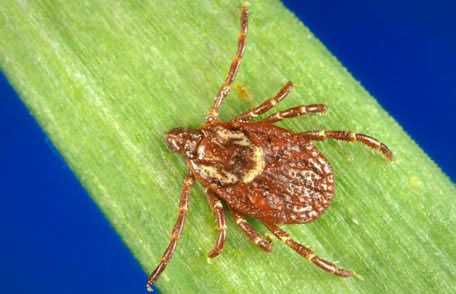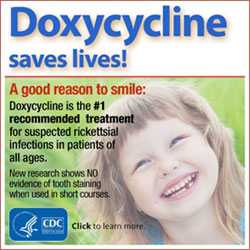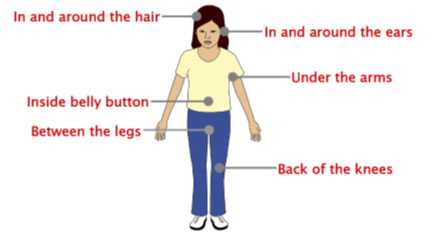RMSF is Deadly, Yet Preventable
 Learn the signs and symptoms of RMSF and what you can do to protect yourself, your family, and your pets from ticks and tickborne diseases.
Learn the signs and symptoms of RMSF and what you can do to protect yourself, your family, and your pets from ticks and tickborne diseases.
Rocky Mountain spotted fever is a serious tickborne illness which can be deadly if not treated early. In fact, more than 20% of untreated cases may be fatal. Early treatment with the antibiotic doxycycline saves lives.
Most people have heard of Lyme disease, but do you know about the most deadly tickborne disease in the world, Rocky Mountain spotted fever?
Rocky Mountain spotted fever (RMSF) is a bacterial disease spread through the bite on an infected tick. RMSF may cause more than 3,000 cases per year in the contiguous United States. More than 60% of reported cases occur in five states (North Carolina, Tennessee, Oklahoma, Arkansas, and Missouri). While the majority of RMSF cases occur during summer months, it is important to keep in mind that ticks can still bite you well into the fall, or even year-round in warmer climates.
Signs and Symptoms of RMSF
Early signs of RMSF are often non-specific with symptoms such as fever and headache. But the disease can rapidly progress to a serious and life-threatening illness. Symptoms may include:
- Fever
- Rash (may be a late symptom or completely absent)
- Headache
- Nausea
- Vomiting
- Stomach pain
- Muscle pain
- Lack of appetite
The progression of the disease varies greatly. People who are treated early with doxycycline may recover quickly, while those who experience a more severe illness may require prolonged hospitalization, or intensive care.
When left untreated, the bacteria can cause damage to blood vessels throughout the body leading to organ and tissue damage. RMSF can be fatal, even in previously healthy people, if not treated correctly, death can often occur within eight days of symptoms starting. Patients who do recover from serious RMSF infections may be left with life-altering damage including amputation of arms, legs, fingers, or toes (from lack of blood flow), hearing loss, paralysis, or mental disability.

Doxycycline is the treatment of choice for adults and children of all ages with suspected RMSF.
Treatment
RMSF, and other rickettsial diseases spread through tick bites, can be effectively treated with the antibiotic doxycycline. This antibiotic is most effective if given within the first five days of symptoms starting. Doxycycline is the treatment of choice for adults and children of all ages with suspected RMSF as recommended by the CDC and the American Academy of Pediatrics. Some health care providers may hesitate to use doxycycline in children because of a warning relating to dental staining from long-term use of tetracycline antibiotics. However, a study by CDC and Indian Health Service found that short courses of the antibiotic doxycycline (used to treat RMSF) can be used in children without causing tooth staining or weakening of tooth enamel. Doxycycline is the best medication for the treatment of RMSF in people of all ages, and when used early in illness, doxycycline can save lives.
Diagnosis and Testing
A reliable laboratory test to confirm RMSF infection early in illness is not available. Diagnosis must be made by a health care provider based on a person’s signs, symptoms, and possible exposure to ticks. Your health care provider can order a laboratory test to confirm an infection, but results may take weeks. Treatment with doxycycline should never be delayed while waiting for diagnostic test results.
Preventing RMSF
No vaccine to prevent RMSF is available, so preventing illness means preventing tick bites. Ticks live in grassy, brushy, or wooded areas, or even on animals, so spending time outside camping, gardening, or hunting will bring you in close contact with ticks. Protect yourself, your family, and your pets. Here’s how:
Before You Go Outdoors
- Know where ticks live. Ticks prefer moist and humid environments, particularly in or near wooded or grassy areas. You may come into contact with ticks during outdoor activities around your home or when walking through leaf litter or near shrubs. Always walk in the center of trails in order to reduce the chance of contacting ticks.
- Use DEET repellent on skin. Repellents containing 20% or more DEET (N, N-diethyl-m-toluamide) are very effective and can protect you up to several hours. Always follow product instructions. Parents should apply this product to their children, avoiding the hands, eyes, and mouth. For detailed information about using DEET on children, see recommendations from the American Academy of Pediatrics.
- Treat clothing and gear with permethrin. Permethrin kills ticks and can be used to treat boots, clothing, and camping gear. Clothing treated with permethrin will provide lasting protection even after several washings.
- Treat your pets for ticks. Dogs are highly susceptible to tick bites and can get tickborne diseases like RMSF too. Tick collars, sprays, shampoos, or “top spot” medications should be used regularly to protect your animals and your family from ticks. Talk to your veterinarian and be sure to use these products according to the package instructions. For more information on animals and health, see Preventing Ticks on Your Pet.
- For detailed information about tick prevention and control, see the Avoiding Ticks page.

Check for ticks after you come indoors.
After You Come Indoors
- Check your clothing for ticks. Ticks may be carried into the house on clothing. Remove any ticks that you find. Placing clothes into a dryer on high heat for at least 1 hour effectively kills ticks.
- Check your dogs for ticks after returning from tick habitats. The most common location for ticks on dogs include the ears, arm pits, groin, around the paws, and in-between the toes.
- Shower soon after being outdoors. Showering within two hours of coming indoors may help wash off unattached ticks, and it is a good opportunity to do a tick check.
- Check your body for ticks after being outdoors. Check your body for ticks! If you have kids, check them for ticks. Use a mirror or have someone help you with hard-to-see areas. Ticks can be found anywhere, but are commonly found:
What to Do if You Find an Attached Tick
Remove any attached ticks from people or pets immediately. To remove a tick grasp it with tweezers, as close to the skin as possible, and pull it straight out. Do not twist or jerk. For detailed information about tick removal, see the Tick Removal page.
Watch for signs of illness in people and pets after spending time in tick habitats, even if you don’t remember a tick bite. RMSF can be treated effectively with doxycycline if caught early, so see your health care provider immediately if you develop a fever, rash, or flu-like symptoms. Be sure to mention to your doctor any history of tick bites or outdoor activities where you might have been in contact with ticks.
RMSF FACT OR FICTION?
If you get RMSF, you will rickettsial diseasesrickettsial diseasesalways develop a rash.
FALSE. While most patients do develop a rash at some point during their illness, this may not occur until a patient has been sick for many days. If you develop a fever or rash after spending time in tick habitats, see a health care provider immediately. Do not delay antibiotic treatment. Never wait for a rash to begin treating a suspected case of RMSF.
I don’t remember being bitten by a tick, so my illness can’t be caused by an infected tick.
FALSE. Tick bites are painless and often go unnoticed. In fact, only 60% people who got RMSF report knowing they had a tick bite.
My health care provider said I should wait for laboratory test results before starting antibiotic treatment.
FALSE. Treatment with doxycycline should be started as soon as RMSF is suspected. Never delay treatment while waiting for a test result!
Doxycycline can’t be given to children because it may stain their teeth.
FALSE. Doxycycline is the treatment of choice for people of all ages who are suspected of having RMSF.
For more information on RMSF, visit our website.
s develop a rash.
FALSE. While most patients do develop a rash at some point during their illness, this may not occur until a patient has been sick for many days. If you develop a fever or rash after spending time in tick habitats, see a health care provider immediately. Do not delay antibiotic treatment. Never wait for a rash to begin treating a suspected case of RMSF.
I don’t remember being bitten by a tick, so my illness can’t be caused by an infected tick.
FALSE. Tick bites are painless and often go unnoticed. In fact, only 60% people who got RMSF report knowing they had a tick bite.
My health care provider said I should wait for laboratory test results before starting antibiotic treatment.
FALSE. Treatment with doxycycline should be started as soon as RMSF is suspected. Never delay treatment while waiting for a test result!
Doxycycline can’t be given to children because it may stain their teeth.
FALSE. Doxycycline is the treatment of choice for people of all ages who are suspected of having RMSF.
For more information on RMSF, visit our website.
- Page last reviewed: October 7, 2016
- Page last updated: October 7, 2016
- Content source:
- National Center for Emerging, Zoonotic, and Infectious Diseases, Division of Vector-Borne Diseases
- Page maintained by: Office of the Associate Director for Communication, Digital Media Branch, Division of Public Affairs




 ShareCompartir
ShareCompartir